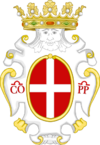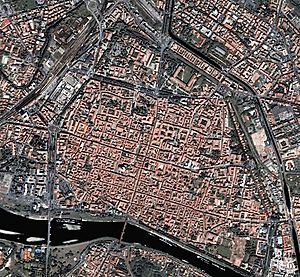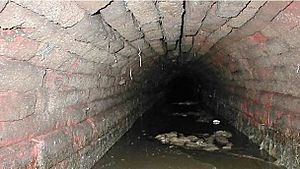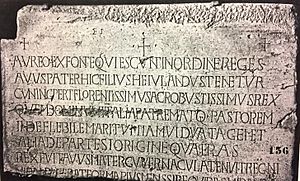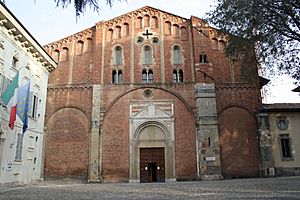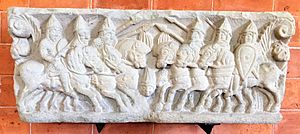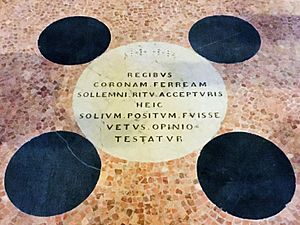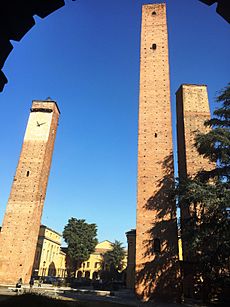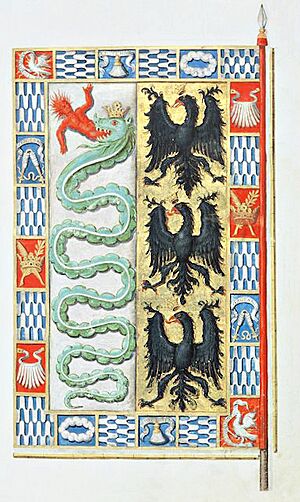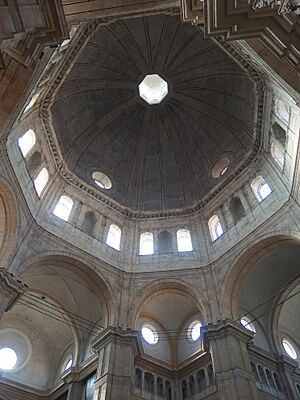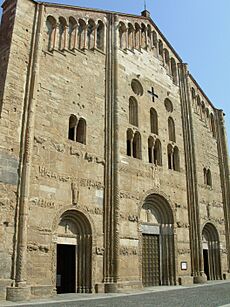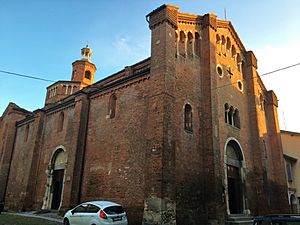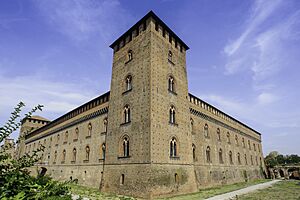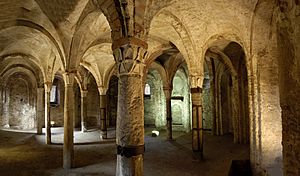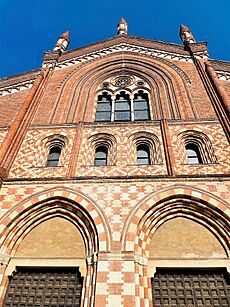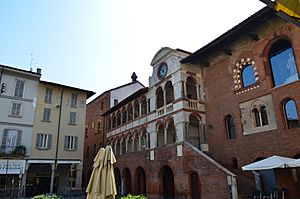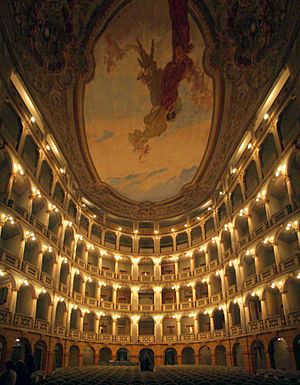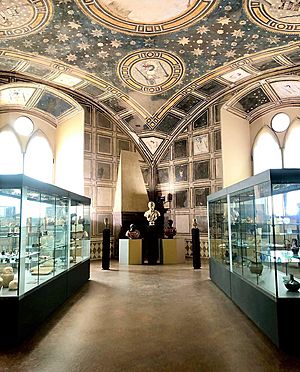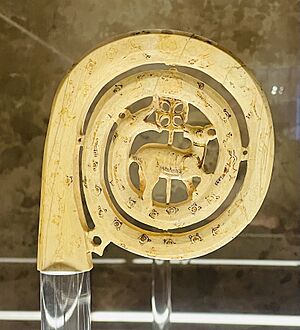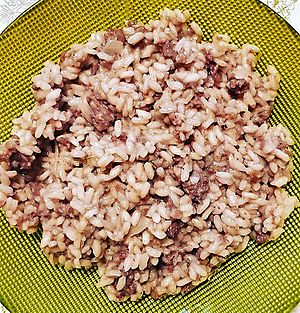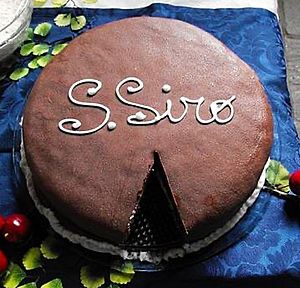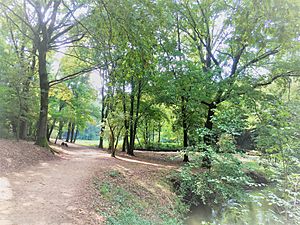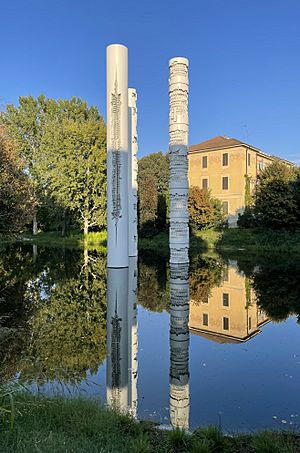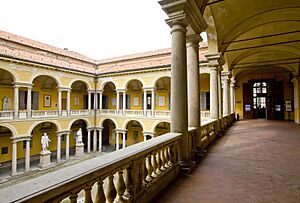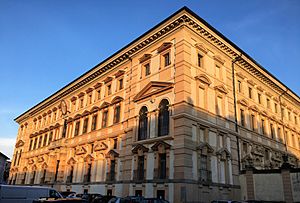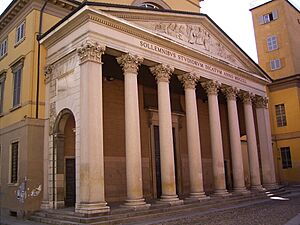Pavia facts for kids
Quick facts for kids
Pavia
|
|||
|---|---|---|---|
| Città di Pavia | |||
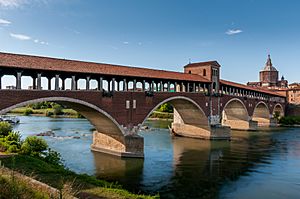
Ponte Coperto and river Ticino
|
|||
|
|||
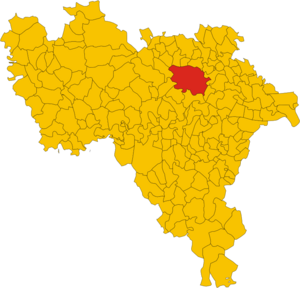
Pavia within the Province of Pavia
|
|||
| Country | Italy | ||
| Region | Lombardy | ||
| Province | Pavia (PV) | ||
| Frazioni | Ca' della Terra, Cantone Tre Miglia, Cassinino, Cittadella, Fossarmato, Mirabello, Montebellino, Pantaleona, Prado, Scarpone, Villalunga | ||
| Area | |||
| • Total | 62 km2 (24 sq mi) | ||
| Elevation | 77 m (253 ft) | ||
| Population
(30 November 2016)
|
|||
| • Total | 73,086 | ||
| • Density | 1,179/km2 (3,053/sq mi) | ||
| Demonym(s) | Pavesi | ||
| Time zone | UTC+1 (CET) | ||
| • Summer (DST) | UTC+2 (CEST) | ||
| Postal code |
27100
|
||
| Dialing code | +39 0382 | ||
| Patron saint | Syrus of Pavia, Augustin | ||
Pavia is a cool town in southwestern Lombardy, a region in Northern Italy. It's about 35 kilometers (22 miles) south of Milan. Pavia is located on the Ticino River, close to where it joins the Po River. About 73,000 people live here.
This city was super important in the Middle Ages. It was the capital of different kingdoms, like the Ostrogothic Kingdom and the Kingdom of the Lombards. It was also a key place for the Visconti family, who were powerful rulers.
Pavia is the main city of the province of Pavia, which is known for its farms. They grow things like wine, rice, and cereals. Even though there are some factories nearby, the town itself feels very peaceful. Pavia is famous for its old University of Pavia, founded in 1361. It's one of the best universities in Italy and even in the world! The city also has many amazing churches and museums, like the famous Certosa di Pavia. Pavia is part of a special nature reserve called the Parco naturale lombardo della Valle del Ticino, which is recognized by UNESCO. It even has two ancient forests that show what the area looked like before people settled there.
Contents
What's in a Name?
In Roman times, Pavia was called Ticinum. Later, during the time of the Lombards, its name changed to Papia, which is where "Pavia" comes from today. It's one of the few Roman towns in Italy that changed its name during the early Middle Ages. No one is completely sure why the name changed!
A Look Back in Time
Ancient Beginnings
Pavia has a very long history, going back even before the Romans. Some say it was founded by ancient tribes called the Laevi and Marici. The Romans called it Ticinum and used it as an important military base. It might have started as a small army camp in 218 BCE, built by a Roman general named Publius Cornelius Scipio. He built a wooden bridge over the Ticino River while looking for Hannibal, a famous general who had crossed the Alps with his army.
Even though the Romans lost a big battle nearby, their camp survived. Over time, it grew into a busy town. Its importance grew because of new roads that connected it to other major cities like Milan and Turin.
The Roman city was built in a grid pattern, with straight streets. The main road, called the "cardo Maximus," is now Strada Nuova. The "decumanus" road is now Corso Cavour-Corso Mazzini. Underneath many of the old streets, you can still find the brick pipes of the Roman sewer system! These sewers worked for over 1,500 years.
Pavia was a key military spot. In 271 CE, the Roman emperor Aurelian defeated an invading tribe near the city. It was also easy to travel by water from Pavia using the Ticino and Po rivers, all the way to the Adriatic Sea.
In 476 CE, the Western Roman Empire officially ended in Pavia. The last Roman emperor, Romulus Augustulus, was removed from power here by a soldier named Odoacer. Odoacer became the new king of Italy. There was a lot of fighting and fires in Pavia during this time, so Odoacer even stopped taxes for five years to help the city rebuild.
Later, a new group called the Ostrogoths, led by Theoderic, took over Italy. Theoderic chose Pavia as one of the cities to rebuild and expand. He started building a huge palace that would later become home to Lombard kings. He also built an amphitheatre and bath complex. A famous Christian thinker named Boethius was imprisoned in Pavia and wrote his most famous book, The Consolation of Philosophy, there.
Pavia was one of the last places where the Ostrogoths resisted the Eastern Roman Empire. From 540 CE, Pavia became the permanent capital of the Ostrogothic Kingdom.
Lombard Capital
In 568 CE, a new group, the Lombards, invaded Italy. Their king, Alboin, captured most of northern Italy, but Pavia held out for over three years! Finally, in 572 CE, the Lombards captured Pavia. Because of its great location and the existing palaces, Pavia became the main capital of the Lombard Kingdom by the 620s.
Under Lombard rule, many monasteries, nunneries, and churches were built in Pavia. Even though some early Lombard kings were Arian Christians (a different type of Christianity), they were usually tolerant of Catholics. Kings and queens built churches to show their faith and wealth, often making them their burial places. For example, King Grimoald built San Ambrogio and was buried there.
One of the most famous churches built by a Lombard king in Pavia is the church San Pietro in Ciel d'Oro. King Liutprand ordered its construction. It became his burial place, and also holds the remains of the philosopher Boethius and the famous Christian writer St. Augustine. St. Augustine's remains were brought to Pavia by Liutprand to protect them from invaders.
Pavia was also where the Lombards made their own coins. The king's face on the coins showed his power. Pavia was the center of the Lombard kingdom until 773 CE, when Charlemagne, king of the Franks, invaded Italy. He besieged Pavia and captured it in 774 CE, ending the Lombard Kingdom in northern Italy. Charlemagne then crowned himself king of these lands.
Medieval Times
In 825 CE, Emperor Lothair I made Pavia an important center for education. Students from many towns in northern Italy had to come to Pavia for school.
Pavia became a very rich and busy city in the 10th and 11th centuries. It was a major trading hub, especially because of its rivers, which connected it to the Adriatic Sea. An Arab traveler named Ibrāhīm al-Turtuši visited Pavia around 960 CE and called it the "main city of Longobardia," full of merchants and built entirely of stone and brick. He was very impressed by a famous statue of a horse and rider, the Regisole, and by the 300 legal experts working in the royal palace.
Pavia remained the capital of the Italian Kingdom and the place where kings were crowned for a long time. In the 12th century, Pavia became a self-governing city. It often sided with the Holy Roman Emperor against Milan, its rival city. Emperor Frederick Barbarossa was crowned twice in Pavia.
Later, Pavia came under the rule of the Visconti family from Milan in 1359. Under their rule, Pavia became a center for learning and art. The University of Pavia grew a lot during this time, attracting students from many countries. The Visconti family also built the huge Visconti Castle and a large park. In 1396, they started building the Certosa, a beautiful monastery that was meant to be their family tomb.
Jewish families also settled in Pavia in the 14th and 15th centuries, helping with finance and even teaching Hebrew at the university.
Later Years
The Battle of Pavia in 1525 was a huge event. The French king, Francis I, was defeated and captured by the forces of the Holy Roman Emperor Charles V. This led to a long period of Spanish rule in Pavia.

During the 17th century, Pavia was besieged by French and other armies but was never conquered. Spanish rule ended in 1706 when the Austrians took over. The University of Pavia grew a lot during this Austrian period, with famous scientists like Alessandro Volta (who invented the battery) and Lazzaro Spallanzani teaching there.
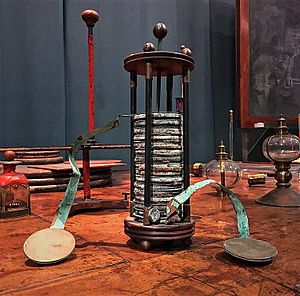
In 1796, Napoleon and his French army occupied Pavia. The people of Pavia revolted, but Napoleon crushed the uprising.
Modern Times
Pavia returned to Austrian control in 1814. In 1859, during the Second War of Italian Independence, Pavia became part of the Kingdom of Italy.
In 1894, Albert Einstein's father moved to Pavia to start a business. Young Albert visited his family here and even wrote an essay during his time in Italy.
During World War II, Pavia was occupied by the German army. In 1944, US air forces bombed the city to destroy bridges, causing damage and civilian deaths. Allied troops entered the city on April 30, 1945.

City Symbols
The symbols of Pavia are its coat of arms, banner, and seal. The banner is red with a white cross, which has been used since at least the 13th century. This symbol showed Pavia's loyalty to the Ghibelline faction, which supported the Holy Roman Emperor. The city's seal shows the Regisole, an ancient bronze statue of a horse and rider. This statue was once in the Royal Palace and later in the cathedral square, but it was pulled down in 1796.
Where is Pavia?
City Layout
Pavia is located in the Po Valley, a large flat area in northern Italy. Much of the old city center sits right on the edge of the Ticino River.
The city is built on a raised area of land that has been shaped by two ancient rivers. This means that old Pavia was almost like an island, surrounded by water on three sides, making it hard to reach.
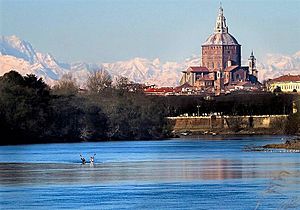
The highest part of the city is near the Visconti Castle, about 80 meters (262 feet) above sea level. It then slopes down towards the Ponte Coperto, where it's just under 60 meters (197 feet) high.
Weather in Pavia
Pavia has a climate typical of the Po Valley. It can be quite humid, especially in late autumn and winter, which often brings fog.
| Climate data for Pavia (2002–2017) | |||||||||||||
|---|---|---|---|---|---|---|---|---|---|---|---|---|---|
| Month | Jan | Feb | Mar | Apr | May | Jun | Jul | Aug | Sep | Oct | Nov | Dec | Year |
| Mean daily maximum °C (°F) | 5.7 (42.3) |
8.4 (47.1) |
14.6 (58.3) |
18.9 (66.0) |
23.6 (74.5) |
28.4 (83.1) |
30.3 (86.5) |
29.2 (84.6) |
24.8 (76.6) |
18.1 (64.6) |
11.7 (53.1) |
6.4 (43.5) |
18.3 (65.0) |
| Daily mean °C (°F) | 2.9 (37.2) |
4.7 (40.5) |
9.9 (49.8) |
14.1 (57.4) |
18.5 (65.3) |
23.1 (73.6) |
24.9 (76.8) |
24.0 (75.2) |
19.8 (67.6) |
14.3 (57.7) |
8.9 (48.0) |
3.8 (38.8) |
14.1 (57.3) |
| Mean daily minimum °C (°F) | 0.1 (32.2) |
1.1 (34.0) |
5.2 (41.4) |
9.4 (48.9) |
13.4 (56.1) |
17.9 (64.2) |
19.4 (66.9) |
18.7 (65.7) |
14.9 (58.8) |
10.4 (50.7) |
6.0 (42.8) |
1.3 (34.3) |
9.8 (49.7) |
| Average precipitation mm (inches) | 67 (2.6) |
67 (2.6) |
70 (2.8) |
72 (2.8) |
81 (3.2) |
72 (2.8) |
63 (2.5) |
80 (3.1) |
64 (2.5) |
105 (4.1) |
102 (4.0) |
71 (2.8) |
914 (35.8) |
| Mean monthly sunshine hours | 95 | 120 | 170 | 195 | 225 | 260 | 305 | 270 | 205 | 155 | 95 | 90 | 2,185 |
| Source 1: Climi e viaggi | |||||||||||||
| Source 2: Istituto Superiore per la Protezione e la Ricerca Ambientale (precipitation 1951–1980) | |||||||||||||
What to See in Pavia
Pavia has many amazing places to visit, showing off its long history and beautiful art.
- Certosa: This famous monastery, founded in 1396, is about 8 kilometers (5 miles) north of the city. It's a must-see!
- Cathedral of Pavia (Duomo di Pavia): This huge cathedral started being built in 1488. Its central dome is the third largest in Italy! Next to it was the Civic Tower, which sadly fell in 1989.
- San Michele Maggiore (St. Michael Major): This church is a fantastic example of Lombard-Romanesque architecture. It was rebuilt around the 11th century and finished in 1130. Many kings were crowned here, including Frederick Barbarossa in 1155.
- Basilica of San Pietro in Ciel d'Oro ("St. Peter in Golden Sky"): This church is said to be the burial place of St. Augustine, Boethius, and the Lombard king Liutprand. It was built in 1132. The beautiful arch holding St. Augustine's relics was made in 1362 and has about 150 statues.
- San Teodoro: This Romanesque church was rebuilt in 1117. It's known for its two amazing old frescoes (paintings) of the city from 1525, which show how little Pavia's layout has changed in 500 years.
- Visconti Castle: Built between 1360 and 1365 by Galeazzo II Visconti, this large castle was a private home, not a fortress. It now houses the City Museums, and its park is a popular spot for families.
- Santa Maria del Carmine: This church is a great example of Gothic brick architecture in northern Italy. It's the second largest church in Pavia after the Duomo.
- Basilica of Santissimo Salvatore: Founded in 657 by the Lombard king Aripert I, this church was a burial place for kings.
- Crypt of Sant'Eusebio: This crypt is what remains of an old church founded in the 7th century. It has interesting old capitals (tops of columns).
- San Francesco d'Assisi: A beautiful late Romanesque church with a Gothic facade, built between 1238 and 1298.
- Broletto: This palace, built in the 12th and 13th centuries, was once the city hall. Now it hosts art exhibitions.
- Old Campus of the University of Pavia: The main campus of the university, built over centuries, features beautiful courtyards and historic classrooms.
- Ponte Coperto: This stone and brick bridge over the Ticino River is a symbol of Pavia. The original bridge was damaged in 1945 and rebuilt starting in 1949.
- Towers of Pavia: You'll see many medieval towers in Pavia's old town. There used to be about 65 of them, built between the 11th and 13th centuries, and about 25 still stand today.
- Teatro Fraschini: This opera house was built between 1771 and 1773.
- Palazzo Mezzabarba: Built in the Rococo style, this beautiful palace has been Pavia's city hall since 1875.
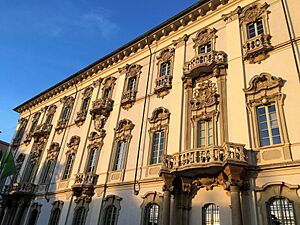
Culture and Fun
Museums to Explore
Pavia has many museums that show off its rich history and art.
- The Pavia Civic Museums are located in the Visconti Castle. They have amazing collections, including Roman glass, Lombard artifacts (like old inscriptions and belt buckles), and Romanesque and Renaissance art. You can also see works by famous artists like Giovanni Antonio Amadeo. The museums also have a collection of African objects and over 50,000 coins!
- The Pinacoteca Malaspina (part of the Civic Museums) displays paintings from the 13th to the 20th century by important Italian and international artists. You can also see a huge wooden model of the Pavia cathedral from 1497.
- The University History Museum has sections on medicine and physics. In the physics section, you can see hundreds of scientific instruments from the 18th and 19th centuries, some of which belonged to Alessandro Volta, the inventor of the battery!

- The Natural History Museum (Kosmos) is one of the oldest in Italy, founded in 1771. It has nearly 400,000 items, including animals, comparative anatomy, and fossils.
- The Golgi Museum is in the actual rooms and labs where Nobel Prize winner Camillo Golgi worked. It's like stepping back in time to a 19th-century research center!
- The Diocesan Museum of Pavia, opened in 2023, is next to the Cathedral. It displays old silver, church objects, sculptures, and paintings.
Delicious Food
Pavia is in a region known for its tasty food, especially rice!
- Rice dishes: Since Pavia is a major rice producer, there are many rice recipes. Try Carthusian risotto (made by monks!), or risotto with sausage and local wine.
- Pavese soup: Legend says this soup was created by a peasant woman for King Francis I after a big battle. It's made with broth, eggs, and cheese.
- Meat dishes: You can find local stews, veal tripe, and "escaped birds" (veal slices with bacon and sage). Meats are often served with two traditional sauces: peverata (made with peppers and anchovies) and bagnet verd (with parsley, anchovies, and capers).
- Fish and more: Because of the rivers, there are also many freshwater fish dishes, like eel and trout. And don't forget frogs (in risotto or stew) and snails!
- Desserts: Besides the famous cake of paradise, try pumpkin pie or San Sirini, small round cakes soaked in rum and covered in chocolate, made around December 9th (Saint Syrus's day).
- Pavese agnolotti: These are a type of stuffed pasta, similar to ravioli, filled with a local stew. They are a traditional dish for Christmas and other special occasions.
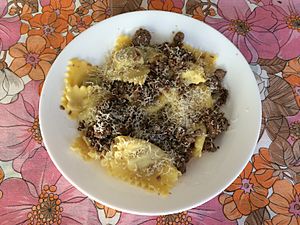
All these dishes go great with wines from the nearby Oltrepò Pavese region.
Green Spaces
Pavia is surrounded by nature! It's part of the Parco naturale lombardo della Valle del Ticino, a large natural park.
- Vernavola Park: This large park, north of the city, is where the famous Battle of Pavia took place in 1525.
- Ticino Valley Natural Park: This park stretches along the Ticino River, creating a green belt around the city.
- Bosco Grande nature reserve and Strict nature reserve Bosco Siro Negri: These two forests are some of the last remaining parts of the ancient lowland forest that once covered the entire Po Valley. They show what nature was like before humans settled here.
- Horti Borromaici: This large urban park in the city center combines nature with modern art. You can see sculptures by famous artists like Arnaldo Pomodoro among the trees and plants.
- Botanical Garden of the University of Pavia: Established in 1773, this garden covers 2 hectares (5 acres) and has many different plant collections, including a rose garden and tropical greenhouses.
Learning in Pavia
Schools
Pavia has over 45 schools, from kindergarten to high school. Some of them are very old, like the Ugo Foscolo classical lyceum, which started in 1557!
Universities and Colleges
Pavia is a major college town in Italy.
- The University of Pavia is one of the oldest universities in Europe, founded in 1361. It even had a school of rhetoric as early as 825 CE! Its main campus has beautiful courtyards and historic buildings. It also has a History Museum and a Natural History Museum.
- Borromeo College and Ghislieri College: These are two of the oldest and most famous colleges in Pavia, founded in the 16th century. They offer scholarships and great learning opportunities for students.
- The IUSS Pavia (Institute for Advanced Studies of Pavia) is a special institute that brings together all five colleges in Pavia, forming the "Pavia Study System."
Healthcare
Pavia has a long history of hospitals, with some dating back to the 8th century. The main hospital today is the Fondazione IRCCS Policlinico San Matteo Hospital, which is very important in Italy. Pavia also has several other hospitals, including specialized ones for neurology and rehabilitation.
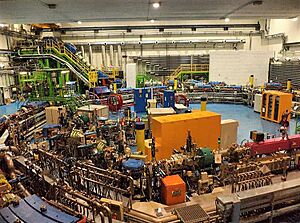
Pavia is also home to the National Center for Androtherapy Oncology (CNAO Foundation). This is a special hospital and research center that treats tough-to-treat cancers using particle therapy. It's one of only a few such centers in the world! The CNAO uses a synchrotron to produce the particles for treatment.
People from Pavia
Pavia has been home to many famous people throughout history.
People born in Pavia include:
- Giovanni Antonio Amadeo (1447–1522), a famous sculptor and architect.
- Gerolamo Cardano (1501–1576), a brilliant scientist.
- Benedetto Cairoli (1825–1889), who was the head of the Italian government twice.
- Antonio Luigi Gaudenzio Giuseppe Cremona (1830–1903), a mathematician.
- Liutprand of Cremona (c. 920–972), a historian and diplomat.
- Ambrogio Maestri (born 1970), a well-known opera singer.
- Max Pezzali (1967), a popular singer-songwriter.
- Bianca Maria Sforza (1472–1510), who became an empress.
- Gian Galeazzo Visconti (1351–1402), the first duke of Milan.
Famous people who lived or taught in Pavia include:
- St. Alexander Sauli (1591–1592), a bishop.
- Alessandro Volta (1745–1827), the scientist who invented the battery.
- Camillo Golgi (1843–1926), a biologist and Nobel Prize winner.
- Ugo Foscolo (1778–1827), a famous Italian writer and poet.
- Dionysios Solomos (1798–1857), the national poet of Greece.
- Lazzaro Spallanzani (1729–1799), a biologist and physiologist.
- Giulio Natta (1903–1979), a Nobel Prize-winning chemist.
Sister Cities
Pavia is twinned with these cities:
 Ayamé, Ivory Coast
Ayamé, Ivory Coast Besançon, France
Besançon, France Bethlehem, Palestine
Bethlehem, Palestine Hersbruck, Germany
Hersbruck, Germany Hildesheim, Germany
Hildesheim, Germany Vilnius, Lithuania
Vilnius, Lithuania Zakynthos, Greece
Zakynthos, Greece
Images for kids
-
Ostrogothic belt buckle, Civic Museums
See also
 In Spanish: Pavía para niños
In Spanish: Pavía para niños



